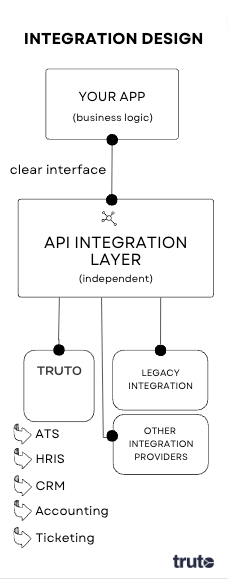Separating the API Integration Layer for Optimal Integration Design: Insights from Lalit, CTO at Clearfeed.ai

Separating the API Integration Layer for Optimal Integration Design
Integration design is an essential aspect of building modern software systems. Integrating various components, services, and applications is necessary to create a seamless user experience, and improve operational efficiency. Since it's end-customer-facing, it's also important to make sure it's fail-safe.
During our conversation with Lalit Indoria, CTO at Clearfeed.ai, he shared his approach to designing a fail-safe integration architecture by separating the API integration layer from the business logic application. This approach is not only the best but perhaps the only way that companies should approach designing their integration architecture. However, we discovered that some companies are yet to adopt this design. In this blog post, we will discuss the critical importance of this approach and the problems that may arise when it is not adopted.
Before we dive into the details, let's define what we mean by the API integration layer and the application holding the business logic.
API Integration Layer
The API integration layer is the middleware that connects different components and services by providing a standardized interface for communication. It abstracts away the complexities of the underlying systems and exposes a consistent set of APIs for other applications to consume.
Your app
On the other hand, the application holding the business logic is the core of the software system, i.e., your app that implements the business rules, data processing, and user interface. It's the component that drives the value of the software system and provides the unique capabilities that differentiate it from others.

Advantages of separating the API integration layer from your application
Decoupling
Firstly, this approach decouples the integration concerns from the core business logic. Integration can be a complex and dynamic process that involves multiple systems, protocols, and data formats. By separating the integration layer, we can abstract away these complexities and provide a clean and consistent interface for communication.
This separation allows us to focus on the core business logic and not worry about the details of the integration. As a result, we can create a more modular, flexible, and scalable software system.
Maintenance and upgrades
Separating the integration layer makes it easier to maintain and upgrade the system. In a traditional monolithic architecture, changes in one component can affect the entire system, making it hard to evolve and adapt. By separating the integration layer, we can make changes to the integration without affecting the core business logic.
For example, if we need to upgrade an integration provider or add a new integration, we can do it without disrupting the existing system. This separation provides us with greater agility and reduces the risk of regression.
Switching between services
Separating the integration layer enables us to leverage existing integration platforms and services. Many integration providers offer specialized services that can handle specific integration scenarios such as data mapping, protocol translation, or event-driven architectures. By using these services, we can reduce the development time and cost of building custom integrations.
And, by separating the integration layer, we can switch between different providers without affecting the core business logic. This flexibility provides us with greater choice and control over our integration strategy.
Security and Monitoring
Separating the integration layer allows us to secure and monitor the system more effectively. The integration layer is the entry point for many external systems and data sources, making it a potential security risk. By separating the integration layer, we can implement security measures such as authentication, authorization, and encryption at the integration layer.
And, by monitoring the integration layer, we can detect and respond to issues such as performance bottlenecks, data inconsistencies, or unauthorized access. This separation provides us with greater visibility and control over the system.
Improved user experience
Having a proper integration layer provides an advantage in delivering a seamless user experience. For instance, when two applications do not communicate effectively, users may have to switch between different interfaces or input the same data multiple times, leading to frustration and reduced adoption. With a well-designed integration layer, data can flow seamlessly between applications, minimizing the need for manual data entry and improving the overall user experience.
Considerations to keep in mind
Increased complexity
Separating the API integration layer from the business logic application may lead to increased complexity in the overall architecture, as it requires an additional layer to manage and coordinate data flow between different systems.
Higher development costs
Developing and maintaining an additional integration layer can require additional resources and development costs, especially if a company lacks the necessary expertise or tools.
Higher latency
Separating the API integration layer can add an additional layer of network latency, as data must be transferred between the business logic application and the API integration layer.
Data inconsistencies
The use of multiple systems can lead to inconsistencies in data formats and data storage methods, which can lead to errors and inconsistencies in the data processing.
Security risks
Introducing an additional integration layer can increase security risks, as it provides an additional potential entry point for attackers to exploit.
However, despite these, the benefits of separating the API integration layer often outweigh the drawbacks, particularly in complex integration scenarios with multiple systems and data sources. With proper planning, design, and management, the disadvantages of this approach can be minimized while realizing the benefits of a more scalable, flexible, and resilient integration layer.
Thanks to Lalit for going over his approach during our conversation. And we hope this post helped you understand the importance of separating the API integration layer from the app that holds the business logic and the difficulties that end customers may face when businesses don't use this design. Here's to designing a seamless, secure, and scalable integration layer that meets your business needs.
Find Lalit on LinkedIn here
